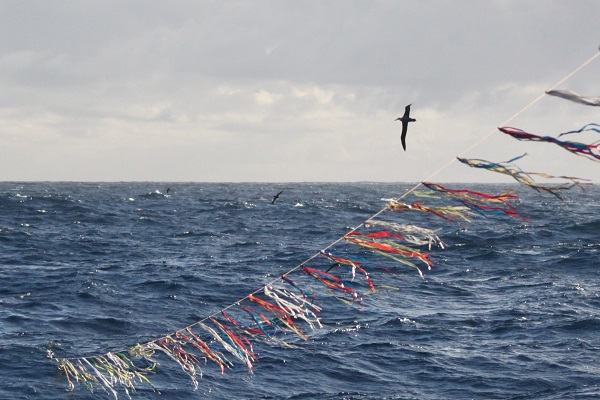
Bird-scaring line in action, photograph from Dimas Gianuca
Stephanie Good (Centre for Ecology & Conservation, University of Exeter, Penryn, UK) and colleagues have reviewed 16 existing National Plans of Action for Reducing Incidental Catch of Seabirds in Longline Fisheries (NPOA-Seabirds) in the journal Biological Conservation.
The paper’s abstract follows:
“Fisheries bycatch is one of the biggest threats to seabird populations. Managers need to identify where and when bycatch occurs and ensure effective action. In 1999, the Food and Agriculture Organization of the United Nations released the International Plan of Action for Reducing Incidental Catch of Seabirds in Longline Fisheries (IPOA-s) encouraging states to voluntarily assess potential seabird bycatch problems and implement a National Plan of Action (NPOA) if needed. However, the IPOA-s is ambiguous about the steps and objectives, diminishing its value as a conservation tool.
We reviewed NPOAs to identify approaches taken to determine whether seabird bycatch is problematic, how bycatch minimisation and population objectives are set, and if thresholds are specified for managing impacts. Our aim was to recommend measures for improving consistency and effectiveness in future NPOAs and other management frameworks for seabirds, with relevance for other threatened marine vertebrates including sharks, turtles, pinnipeds and cetaceans. Globally, 16 NPOAs have been published, but few effectively linked seabird bycatch risk, objectives and management. However, we identified the following best-practice elements that could improve NPOA design: (1) defining explicit risk criteria and methods to assess bycatch problems; (2) setting specific and measurable objectives for minimising bycatch and achieving desired population status; and (3) defining fishery-specific thresholds to trigger management action linked to the population objective. Consistent adoption of NPOA best practice, particularly in states that have not already developed an NPOA, would help to mitigate bycatch threats and ensure fisheries do not reduce the viability of seabird populations.”
Reference:
Good, S.D., Baker, G.B., Gummery, M., Votier, S.C. & Phillips, R.A. 2020. National Plans of Action (NPOAs) for reducing seabird bycatch: Developing best practice for assessing and managing fisheries impacts. Biological Conservation Vol. 247. doi.org/10.1016/j.biocon.2020.108592.
John Cooper, ACAP Information Officer, 15 May 2020

 Español
Español  English
English  Français
Français